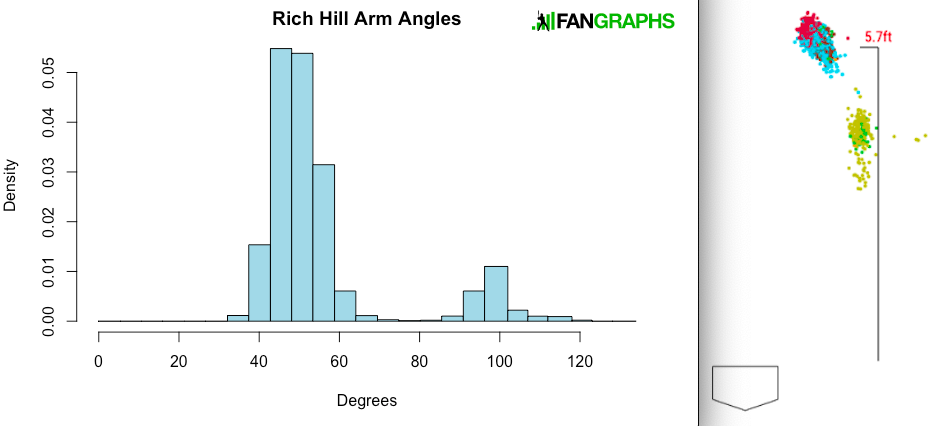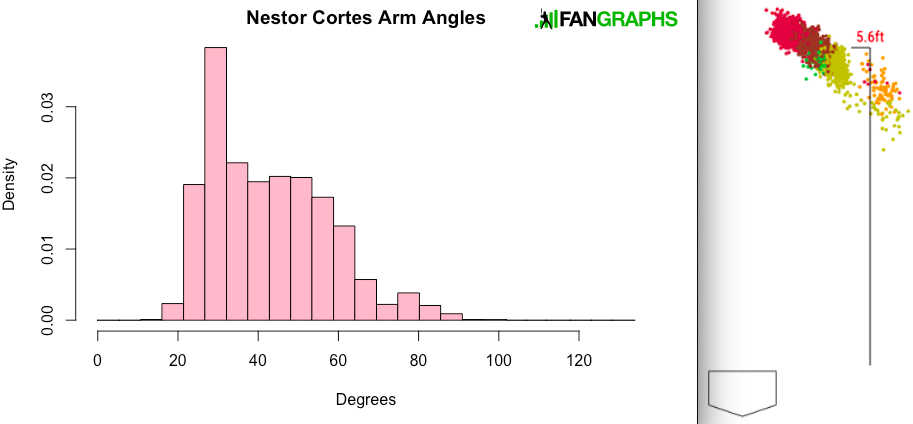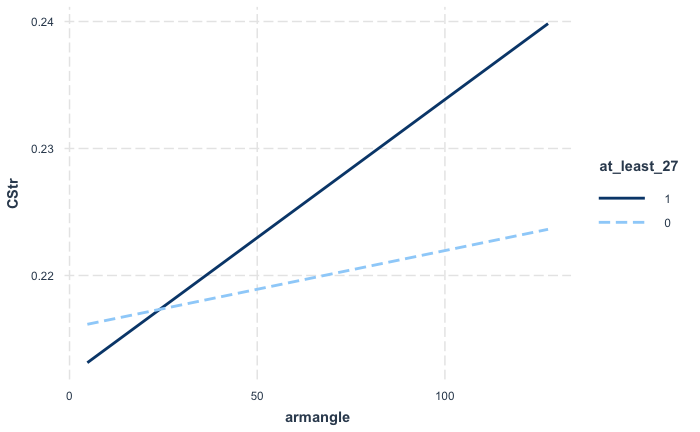[ad_1]

Final week, I wrote about arm angles, Nestor Cortes, and a few appearance-based expectations hitters may need a couple of pitcher’s craftiness. Throughout my information mining, I additionally observed that Rich Hill popped up at or close to the highest of many arm angle rankings. Particularly, among the many 473 hurlers who threw at the very least 500 pitches in 2022, Hill had the broadest vary of arm angles and the second-highest arm angle normal deviation. Beneath are his launch factors in colourful dot type (by way of Baseball Savant) and his arm angle frequencies in histogram configuration:

Hill sometimes comes at hitters from a three-quarters slot, although he does close to a totally overhand slot at occasions. When he drops down, he gives his foes with something from a sidearm to a completely submarine look. Cortes, for his half, positioned second in vary (simply 0.4 levels behind Hill) and fourth in normal deviation (2.5 levels behind). However as you possibly can see under, Cortes’ extra important drop-downs weren’t solely much less frequent than Hill’s but additionally nearer to a extra typical Cortes look. Whereas Hill has a really apparent hole between his drop-down and normal launch, Cortes runs the gamut of angles between the 2:

But, regardless of the way it would possibly seem, the bimodal measurements I utilized in my final article had Cortes’ arm angle distribution as extra intently resembling one with two peaks. So I created my very own measurement of bimodality. First, I bucketed arm angle values into 25 teams, every spanning about 5.3 levels — the identical bucketing I used for the histograms above. For any given pitcher, I denoted a peak bucket when the relative frequency of their arm angles was decrease on all sides of stated bucket. Additional, the pitcher needed to throw at the very least 1% of their choices inside a bucket for it to be a peak candidate; the overall share for every bucket within the histograms may be discovered by multiplying the “density” worth by 5.3. This definition of bimodality included each Hill and Cortes’ distributions as bimodal.
In keeping with the measurement, I discovered that pitchers with bimodal arm angle distributions had considerably decrease swinging strike charges (10.6% in comparison with 11.5%). For what it’s price, there have been additionally two multimodal pitchers — Wandy Peralta (who’s recognized to combine in a quick-pitch as nicely) and Trent Thornton — whose histograms you will discover under:

These guys’ distributions appeared fairly bimodal themselves. So I additionally tried denoting a peak bucket when the relative frequency of arm angles was decrease throughout two buckets on all sides of the height bucket. However there have been solely 5 gamers who met this definition of bimodal — Hill, Tyler Anderson, Rowan Wick, Ralph Garza Jr. (whom Davy Andrews wrote a wonderful piece about final month), and Thornton. Not even Peralta met this stringent definition.
Thus I returned to my first definition, this time together with Peralta and Thornton as bimodal, and sought a special methodology of controlling for any imperfections. Provided that in response to this definition, peaks in bimodal distributions may very well be in shut proximity, I made a decision to have a look at the space (i.e., variety of buckets) between peaks to distinguish amongst bimodal-ers. To evaluate the impression of peak distance, I restricted my pattern to the 45 pitchers with bimodal distributions (this time together with Peralta and Thornton). This pattern was admittedly small, so take the outcomes with a heap of salt:
Peak Distance Impacts
| Peak Dist | SwStr% | CStr% | Zone% | O-Swing% | Z-Swing% | n |
|---|---|---|---|---|---|---|
| 2 | 11.2 | 16.7 | 48.4 | 28.8 | 66.3 | 14 |
| 3 | 10.2 | 16.4 | 48.8 | 27.8 | 67.8 | 19 |
| >= 4 | 10.9 | 17.5 | 50.1 | 31.5 | 66.4 | 12 |
| Bimodal Complete | 10.7 | 16.8 | 49.0 | 29.1 | 66.9 | 45 |
| Unimodal | 11.5 | 16.3 | 48.5 | 29.2 | 67.6 | 428 |
Probably the most eye-popping quantity is within the chase-rate column: O-Swing% jumps previous 30% as soon as we attain a peak distance of 4 buckets. This pattern additionally passes the odor check — it is sensible that batters would chase extra, misidentifying a pitch’s location, when they’re topic to wildly totally different arm slots. There’s additionally a rise in called-strike price as soon as we attain a peak distance of 4 buckets, however I’m extra skeptical of this improve as a result of it’s not as massive and it corresponds with a large improve in zone price. This skepticism comes regardless of my findings from final week that extra obtuse common arm angles correlated with larger called-strike charges; new for this week, per the directions of an astute commenter on my final article, I double-checked that these findings had been sturdy sufficient to resist a zone-rate management (they had been).
My most notable discovering from final week, although, was that this called-strike impact seems to be moderated by body-mass index (BMI). I’ve since found that it’s moderated by a number of different comparable measurements, which is perhaps an extra indication that hitters anticipate extra sidearm appears to be like from sure hurlers. But, listed weights don’t seem like significantly exact or well-maintained by groups, whereas metrics like BMI are fairly crude and have notable imperfections. Moreover, they wouldn’t clarify why Wealthy Hill, whose BMI is correct in the course of the pack, is likely one of the most profitable drop-downers; for one, Hill simply bested Cortes’ above-average called-strike price by a 20.2% to 17.2% margin, rating twenty first in my 473-man pattern. Is there one thing else that stands out in regards to the tall left-hander?
Hill is a southpaw (as is Cortes), however that wasn’t it; there was no interplay between common arm angle and handedness. Hill has a reasonably massive peak distance — at 10 buckets aside, his two peaks had been additional than anybody not named Ralph Garza Jr. However even when we imagine the affiliation between peak distance and chase price, Hill’s got here in under common at 27.3%, in order that’s most likely not what we’re on the lookout for both. Might age be the moderator of curiosity in relation to Hill? In any case, he was the oldest participant in my dataset of 473 pitchers, two years the senior of the subsequent oldest (Adam Wainwright).
To reply this query, I first created a dummy variable for age. I selected 27 as a cutoff as a result of pitchers usually stay inside 5% of their peak efficiency (by ERA-) up till that age. This efficiency decline correlates extremely with a decline in fastball velocity, as pitchers on common additionally stay inside about 1 mph of their peak pace till they flip 27. Provided that fastball velocity drops predictably as pitchers age and sometimes corresponds with a transfer in the direction of fastball options, I managed for a weighted common of fastball velocity that included four-seamers, sinkers, and cutters. I additionally managed for whole fastball utilization price, which was a straight sum of the usages of the three kinds of fastballs, and zone price. Whereas the controls rendered the interplay time period statistically insignificant, here’s what it appeared like graphically:

For these plots, the hidden variables are saved fixed (in order that the one change wrought by them is by way of the intercept), which is perhaps making the interplay appear extra essential than it’s. Even on this plot although, larger common arm angle didn’t correlate considerably with called-strike price for pitchers youthful than 27. However for pitchers age 27 or older, these with extra obtuse arm angles tended to be far more practical at nabbing additional known as strikes, and this held up in opposition to all of the controls even after I ran a regression with a dataset winnowed down to simply the 326 pitchers who had been at the very least 27 final yr.
Why would possibly hitters freeze extra typically in opposition to older pitchers with extra obtuse arm angles than youthful ones? There may very well be some extent of survivorship bias, because the pitchers who lasted lengthy sufficient to stave off a velocity and/or efficiency decline had been most likely more proficient at notching known as strikes to start with. Moreover, for older pitchers, extra obtuse arm angles is perhaps indicative of a bigger high quality of adaptability; if the pitcher is keen to attempt unconventional arm angles (whether or not they start doing so later of their profession or as an newbie participant), they’re most likely extra prone to make use of different tweaks with a purpose to proceed defying father time.
Even when hitters suppose they know what’s coming from Wealthy Hill, as his late-career resurgence enters its eighth yr, it’s the lefty’s willingness to regulate that has saved him round so lengthy. From his extraordinarily excessive and revolutionary curveball utilization to his alternating arm angles, there’s a motive he’s been the sixth-best starter by ERA+ (min. 500 innings) from age-35 onward because the Divisional Period started in 1969. That doesn’t imply the Hill technique will work for everybody; whether or not totally different arm angles really feel pure stays extraordinarily essential. In that vein, my findings don’t essentially point out {that a} change in arm angle will mechanically include a rise in called-strike price; what I’ve studied has largely been about how pitchers with already obtuse arm angles generate extra known as strikes. Nonetheless, operating up that Hill is unquestionably price a shot, particularly for struggling older pitchers.
[ad_2]
Source link


